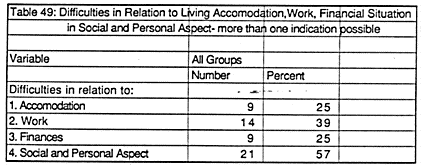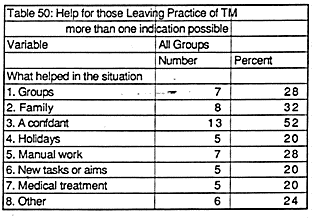6.2. DIFFICULTIES AFTER GIVING UP OF
T.M.
Other difficulties listed by people after the termination
of links with T.M. were - no apartment (i.e. no place in
which to live), bad job prospects and tight financial
situation. Meditators who were completely involved in the
organization had to build a new existence for themselves,
since they had in most cases sacrificed years of time,
money, and energy on the T.M. movement.
Table 49:
Difficulties in
relation to living accommodation, work, financial
situation, in social and personal aspect. (more than one
indication possible).

Examples:
"He's now living at home again, even thought[sic] he
didn't live there before. He's unable to work, can't take
any pressure whatsoever and has no income." (1/97)
"He spent 14 days at home and after that had to stay in
various clinics; is unable to work. We [parents] supported
him financially." (1/97)
"We had to leave our apartment, of which a part was used
as the local T.M. center. Our son was only fit to work as
an unskilled laborer." (1/97]
"I had to leave Seelisburg and had no place to stay, so I
lived with my girlfriend. As regards work, I could do just
about nothing." (2/97)
"I had signed a guarantee to a financial institution,
which I now had to honor." (2/97)
"Little work satisfaction, headaches, slow in thinking. It
took two years for me to start on a new basis. I was also
earning a lot less after two years" (2/97)
In the social sphere 57% (21) had difficulties after
stopping T.M. Ex-meditators report of social isolation,
withdrawal symptoms, desperation and inability to work.
Not only were problems resulting form[sic] physical
illness alleged, but also as a result of the shift in the
framework of perception and the leaving aside of the
mantra, which, after years of use cannot be forgotten and
crops up in all types of situations; and with it all the
memories of the T.M. period. It often takes years before
ex-meditators can come to terms with what happens during
this time.
Examples:
"A lot of furniture had to be taken away, because they
were a reminder of the T.M. thing." (2/97)
"He made several attempts to become independent of
Seelisburg. After Seelisburg was over, everything went
forward again, and L. was more reality-oriented."( 1/97)
"I had withdrawal symptoms. When I stopped the mediation,
I slept an awful lot. During my holidays I took up with
the mantra again, and I went all funny again, I just
wanted to sleep again," (2/98)
"Since I've stopped meditating, everything with the T.M.
people is wrecked, they were really angry with me. They
had a huge amount of arguments ready and were able to give
me an answer for everything. A friend and two others
really let me have it, they were living in the T.M.
center." (2/98)
"Towards the end of my T.M. phase I had become so
sensitized, that I had to take drugs so that I could make
it bearable." (2/98)
"I had no contact with meditators or my social
surroundings, I lived in isolation." (2/98)
"Inside I was often just despairing." (2/98)
"I thought I wasn't normal and wasn't suited to the
others. I had no pattern anymore, spoke a lot faster and
didn't know what to do with myself." (2/98)
 Confidants (52%) and families (32%) were the most common
forms of help for those stopping the practice. Also a help
were groups, manual work (28%), holidays (20%), new aims
or tasks (20%) and medical treatment (20%).
Confidants (52%) and families (32%) were the most common
forms of help for those stopping the practice. Also a help
were groups, manual work (28%), holidays (20%), new aims
or tasks (20%) and medical treatment (20%).
Those meditators could be helped most effectively who
still had good surviving relationships to their families,
who met with an understanding person with whom they could
discuss their experiences, and who in a group took on a
cheerful lifestyle (physical, mental or musical
activities). In this way ex-meditators were able to build
up a critical barrier against the specific T.M. oriented
perception of reality. They learned to deal with everyday
reality, normal stress situations, and have a relationship
with people who were themselves non-meditators.
Up until then T.M. was seen as a fulfilling set of
meaningful values. After they stopped T.M., meditators, as
a rule, distanced themselves from those meaningful values
as well. A vacuum is created which some meditators fill by
getting involved in other Hindu-oriented and antrophosophical organizations*, or by
conversion to Christianity. 47% of those in our
investigation had learned T.M. because they sought a
meaningful purpose. They were disillusioned with T.M. They
had to look for more durable truths and values.
*[translator's note:] I have used the word
antrophosophical; it has to do with teachings like Rudolf
Steiners.
[top ]